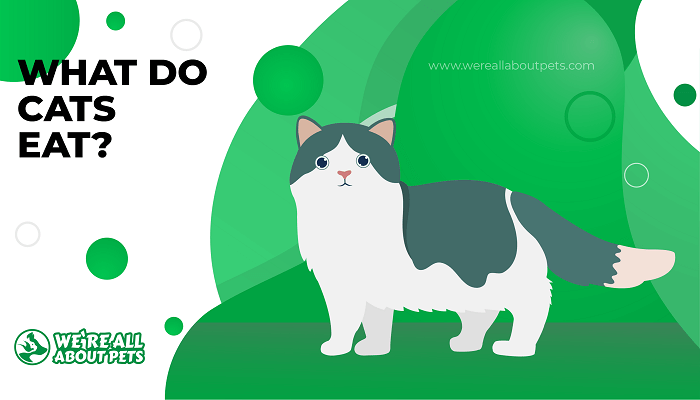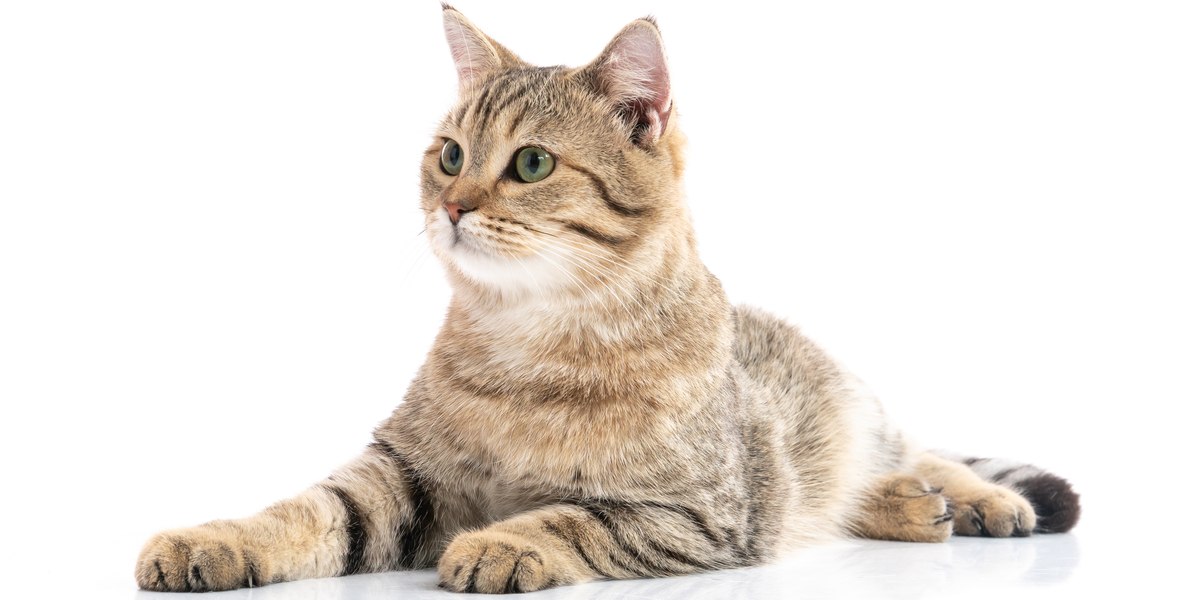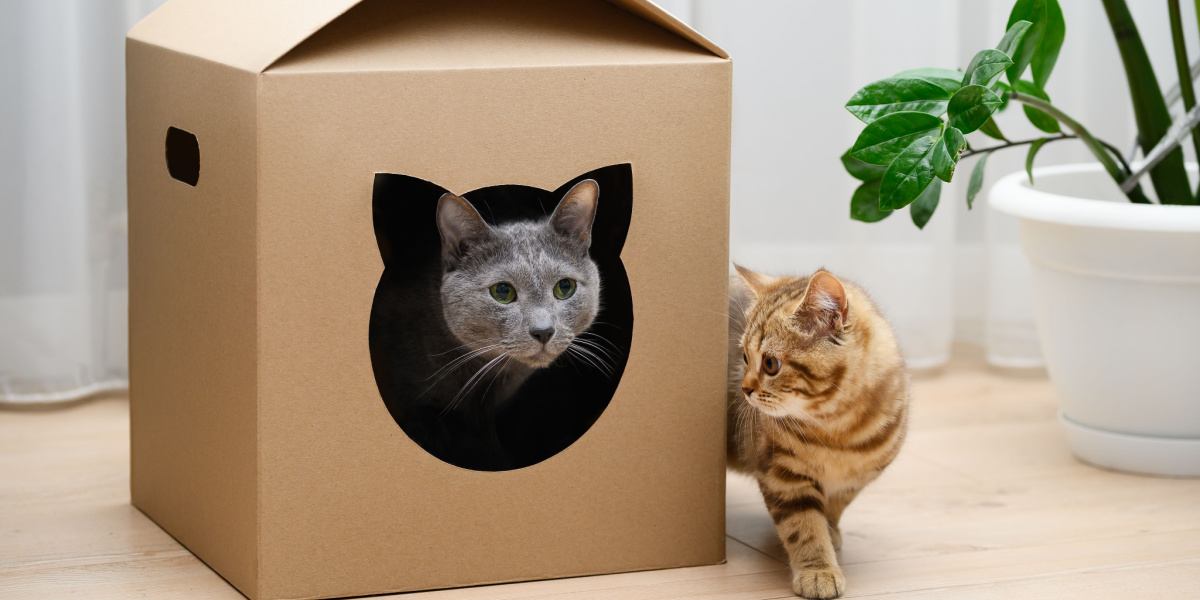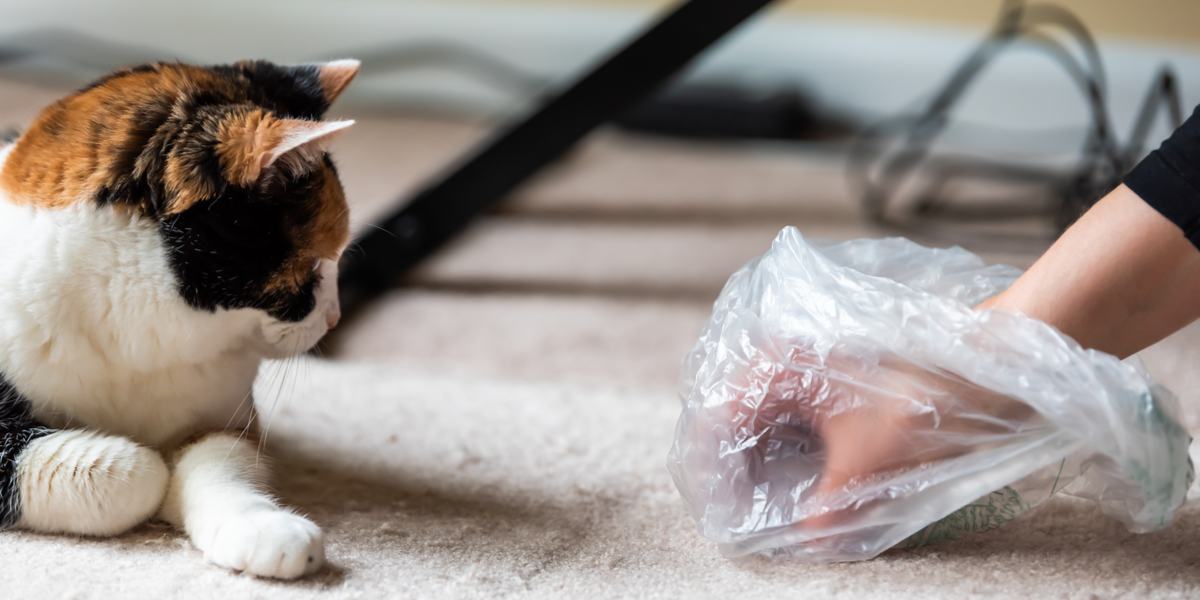What Do Cats Eat?
This page contains affiliate links. We may earn money or products from the companies mentioned in this post through our independently chosen links, which earn us a commission. Learn More

No matter what type of pet you have, your biggest responsibility is providing for your pet’s nutritional needs. When it comes to owning a cat, you may think that’s as simple as running to the grocery store to grab a can of cat food.
While that may work, you should know not all cat foods are created equal.
It’s your job as a cat owner to understand your cat’s nutritional needs and to make a smart and healthy choice when it comes to his diet. You also need to know what foods to avoid.
Here’s what you need to know about what cats can and can’t eat.
Safe And Unsafe Foods For Cats
Though cats have a reputation for being picky eaters, you can’t assume that your cat somehow knows what is and is not safe to eat. It’s your responsibility as a pet owner to keep your cat safe, and that means knowing what foods are healthy and what foods might be toxic.
To make things a little easier on you, we’ve assembled a list of dozens of human foods that are and aren’t safe for your pet cat. Check them out below!

20 Foods That Are Safe For Cats:
- Commercial cat food
- Cooked beef
- Cooked chicken
- Cooked turkey
- Cooked lamb
- Cooked venison
- Cooked rabbit
- Cooked eggs
- Cooked or canned fish
- Cooked seafood
- Apples
- Asparagus
- Bananas
- Berries, including blueberries
- Carrots
- Cucumber
- Melon
- Spinach
- Pumpkin
- Sweet potatoes
Although veggies are safe for cats, don’t be surprised if your cat turns your nose up at them.
8 Foods Cats Can Eat In Moderation:
- Bread
- Cereal
- Peas
- Cooked whole grains
- Yogurt
- Peanut butter
- Hard cheese (low lactose)
- Cottage cheese
10 Foods That Are Not Recommended For Cats:
- Seeds
- Nuts
- Coconut
- Dairy products
- Cooked bones
- Salty foods
- Sugar
- Fat trimmings
- Processed meats
- Raw potatoes
15 Foods That Are Toxic Or Harmful To Cats:
- Alcohol
- Avocado
- Chocolate, especially dark chocolate
- Coffee and tea
- Citrus fruits
- Macadamia nuts
- Onions
- Garlic
- Grapes
- Raisins
- Xylitol
- Raw dough
- Raw meat
- Raw fish
- Milk
Although it can be heartwarming to picture a cat sipping from a bowl of warm milk, cats become lactose intolerant after the kitten stage. This lactose intolerance, which causes digestive issues, is why milk is on the list of toxic foods for cats.
Raw meat is considered harmful to cats because it can contain bacteria like Salmonella and E. coli that can make cats quite sick.
Understanding which foods are and are not safe for your feline friend is very important, but you also need to know the basics about your cat’s nutritional requirements if you want your cat to be healthy. Read on to learn the specifics of what to feed your cat at different life stages.
Types Of Cat Diets
Before getting into the details of what a commercial diet looks like for cats, let’s take a moment to explore your cat’s nutritional needs. The first thing you need to know is your cat is a carnivore.
When you hear the word “carnivore,” you probably think of terms like “meat eater.” If so, you’d be correct, but do you know what that really means? Being a carnivore is more than just a dietary preference – it’s a matter of evolution, anatomy, and biology.
Your cat is a domesticated cat. He’s descended from wild cats and, though he may look nothing like the great African lion on the outside, he’s more similar on the inside than you may realize.
Carnivores have certain biological adaptations that help them hunt, along with anatomical adaptations that help them digest meat. For example, your cat’s digestive tract is much shorter than that of an herbivore because meat is easier to digest than plant matter. Cats also have sharp teeth and strong jaws designed to grab and rip prey, rather than large molars designed to grind up leaves and grass.
Meat is not just an important part of your cat’s diet, it’s essential. Cats, whether wild or domestic, are obligate carnivores, meaning that they must have meat in their diet. In fact, animal-based protein is the most important element in feline nutrition. If your cat’s diet doesn’t contain enough animal protein, his body may start to break down his own muscles and tissues to meet his protein needs.
Here is a quick breakdown of the different components of a pet cat’s diet:

- Animal Protein– Animal protein is the most important element of a feline diet, and ideally comes from animal sources like meat, poultry, and fish. Cats simply cannot digest plant matter efficiently, and plant proteins do not provide all of the essential amino acids your cat needs. Amino acids are the building blocks of proteins.
- Animal-Based Fats– Healthy fats provide a concentrated source of calories for cats, along with essential fatty acids. For cats, these essential fatty acids are linoleic acid, linolenic acid, arachidonic acid. Complicated names aside, your cat needs a balance of these fatty acids, ideally from animal sources like chicken fat and salmon oil.
- Vitamins and Minerals– Your cat needs certain vitamins and minerals in his diet, ideally from natural sources. Examples of vitamins include A, B, D, E, and K. Examples of minerals are sodium and potassium. Many commercial cat foods rely on synthetic supplements to supply these essential nutrients.
- Water– All living things require water, and your cat is no exception. Because they are evolved from desert animals, however, cats don’t tend to drink a lot of water on their own. Cat owners sometimes have to get creative with adding water to their cat’s diet, such as by more feeding wet food and using cat water fountains.
Take another look at that list – what do you notice? Carbohydrates are not listed.
Because cats are obligate carnivores, they don’t digest plant foods well. In fact, cats don’t have any biological need for carbohydrates in their diet. Many commercial cat foods contain plant foods, however, so it’s important to look for recipes that have very low carb content (ideally under 10%). The carbs that are included need to be wholesome and highly digestible.
Now that you know what kinds of foods will make up your cat’s diet, you’re probably curious to know how much to feed your cat. Keep reading to learn about feeding recommendations for pet cats.
Meeting Your Pet Cat’s Nutritional Needs
Shopping for cat food can be difficult because there are so many different options to choose from. The best way to make your choice is to use the guidelines above to narrow down the options, then make a direct comparison between the remaining options to select the one that is best for your cat. If this still sounds daunting to you, your veterinarian can recommend cat foods according to your cat’s age, size, and health status.
All cats have the same basic nutritional requirements. That being said, cats may need different concentrations of those nutrients during different life stages.
Animal protein is the most important nutrient for a cat’s diet and should always be the first ingredient in your cat’s food. Real meat, poultry, or fish should top the list of ingredients. Ideally, animal products should make up 2 of the first 3 ingredients. Avoid any cat food that lists a plant as the first ingredient.
Regarding specific requirements, kittens require 30% protein and adult cats require 26% protein.
These requirements were determined by the Association of American Feed Control Officials (AAFCO), yet it’s important to remember that these values are an absolute minimum. The higher the protein content and the lower the carbohydrate content of your cat’s diet, the better. Again, we recommend a maximum of 10% carbohydrate for cats.
Compared to adult cats, kittens require more protein in their diets to fuel their growth and development. Once your cat reaches adulthood, the primary goal shifts to maintaining a healthy body weight.
Fat provides a concentrated source of calories (energy) for your cat so, again, kittens may need more than adults. According to AAFCO, the minimum requirement for all cats is 9% fat. Though it’s best to give your cat as much protein as possible, you may need to moderate your cat’s fat intake for the sake of controlling his calorie intake. Give your cat the fat he needs but avoid products that contain too much fat because that could lead to unhealthy weight gain.
Aside from protein and fat, the rest of your cat’s diet will be made up of moisture, small amounts of fiber, and vitamins and minerals. Remember that your cat has a limited ability to digest plant materials, so avoid high-fiber foods because that fiber is likely from plant-based sources.
Before we go further, we must mention taurine. Taurine is an essential amino acid for cats. It is considered essential because cats cannot produce this amino acid in their bodies and must get it from their diet. A taurine deficiency can cause serious health issues, such as vision loss and heart problems.
To give you an idea of what and how much you should be feeding your pet cat in different stages of life, refer to this chart:
Daily Cat Feeding Chart |
||||
| Age | Size | Protein (% of diet) | Fat (%of diet) | Treats |
| Birth to 8 weeks | Baby | Mother’s milk or kitten formula, gradually transitioning onto solid food |
||
| 2 to 12 months | Small | 30% (minimum) | 9% (minimum) | 10% maximum |
| 1 year + | Adult | 26% (minimum) | 9% (minimum) | 10% maximum |
| Senior | Adult | 26% (minimum) | 9% (minimum) | 10% maximum |
When feeding your cat, remember that while all cats have the same basic nutritional requirements, calorie needs vary depending on the cat’s size and age.
Kittens require a much higher concentration of calories than adult cats to fuel their growth, so you may need to feed your kitten more than you’d feed an adult cat. As an adult, your cat’s food requirements will be determined by his age, size, and health status. The larger the cat, the more calories it needs. Again, remember that animal protein is always the most important, and fat should be kept in balance.
As your adult cat approaches his senior years (10 to 11 years of age), his metabolism will slow down. Therefore, he will not need as many calories. Work with your veterinarian to adjust your cat’s portion sizes to reduce calorie content, or switch to a recipe with lower fat to reduce the calories. Even with lower calorie counts, though, senior cats still require high-quality animal protein in their diets to maintain good health.
Many cats live 15 to 20 years, so you may not notice any changes in your cat’s activity or mobility during the first few senior years. Even so, it’s a good idea to reevaluate your cat’s diet and make changes if you and your veterinarian deem them necessary.
The quality of the ingredients in your cat’s diet is just as important as the diet’s nutritional composition. Read on to see our recommendations for high-quality cat foods.

Recommended Cat Foods
There are plenty of cat foods out there, but some aren’t worth your consideration. It can be difficult to choose with so many different options available, but we’re here to help! We’ve reviewed many of the top cat food brands on the market to help you narrow down the options.
Here are some of our top picks for the best cat food:
- Nutro Cat Food– One of our favorite brands, Nutro offers numerous cat food products that are free from fillers, by-products, and artificial additives. Shop their selection of wet and dry foods, including high-protein and limited ingredient recipes.
- Merrick Cat Food– This brand offers cat food products that deliver “health you can see.” Their cat foods are rich in real animal protein, healthy animal-based fats, and vitamins and minerals.
- Weruva Cat Food– If you’re looking for a way to increase the moisture content of your cat’s diet, Weruva wet foods and meal toppers are a perfect pick. They are packed with protein and moisture but incredibly low in carbohydrates.
- Nulo Cat Food– This brand offers nutritious pet food products formulated with premium natural ingredients including high-quality animal proteins and real animal fats. Choose from a wide variety of dry food, wet food, and freeze-dried cat food products.
Looking for more recommendations on what to feed your cat? Check out our reviews of popular commercial cat food brands.
Frequently Asked Questions
What do cats eat in the wild?
Domestic cats are evolved from wildcats native to Northern Africa and the Near East. As such, cats are considered obligate carnivores which means they are predators evolved to follow a meat-based diet. In the wild, cats consume prey animals.
How much do cats eat?
The calorie needs of a cat are influenced by its age and size. As a kitten, cats need a higher concentration of calories than they do as adult cats. Their calorie needs may decline further as the metabolism slows in seniority. Most cats need somewhere between 25 and 35 calories per pound of body weight per day.
What do cats drink?
Cats drink water but, because they are evolved from desert-dwelling species, they don’t tend to drink a lot of water on their own. You should give your cat access to fresh water but should also consider ways to add moisture to the diet by feeding fresh food or wet food.
Do cats eat insects?
Insects are part of the natural diet for wild cats. For domesticated cats, however, catching and eating insects is more for sport than for nutrition.








